Benefits of onsite stormwater management
Why do I need to incorporate stormwater management measures into my development?New developments generally increase the area of the site that is covered by hard surfaces, i.e. roofs, driveways and paths. This reduces the amount of green spaces on the site. The trees, shrubs and ground covers in these green spaces intercept rainfall before it reaches the ground and rainfall falling on green spaces will soak into the soil, before runoff is generated.
This increase in hard surfaces results in more stormwater runoff leaving the site during storm events, which contributes to:
- local flooding
- erosion of urban streams
- pollution of waterways and the marine environment.
Efficient stormwater management in new developments has multiple social, economic and environmental benefits including:
- reducing supply costs for potable water where retention storage is incorporated to supply toilets, hot water services, laundry washing and cold-water outlets, and irrigation systems
- improving effectiveness and extending life of existing stormwater infrastructure
- reducing flood risk and resultant damage
- delaying or eliminating the need for major infrastructure upgrades
- improving stormwater quality to protect coastal environments from pollution
- protecting the integrity of urban water courses from erosion
reducing impervious surfaces resulting in reduced heat and stormwater runoff - creating greener urban environments with high visual amenity and increased positive health outcomes.
What is the benefit of connecting my rainwater tank to more than one internal use?
The majority of the cost of your household rainwater use scheme is in the cost of the tank and pump. The plumbing connections are generally a fraction of the cost of the entire rainwater use system. So, for the additional $250-750 to connect to all toilets, your laundry cold taps or hot water service, in addition to a single toilet, you can significantly increase the volume of rainwater you can harvest and use in your home.
The more rainwater you use from your rainwater tank, the more likely it is that you will have available storage space to capture rainwater from the next storm event.
The more rainwater you use, the more rainwater you can store
– the better value you get from your tank
This means that your rainwater tank helps to prevent excess stormwater runoff from your roof draining to the kerb and gutter or Council’s drainage system. This, in turn, helps to minimise the likelihood of local flooding.
Performance objectives and compliance
Performance objectives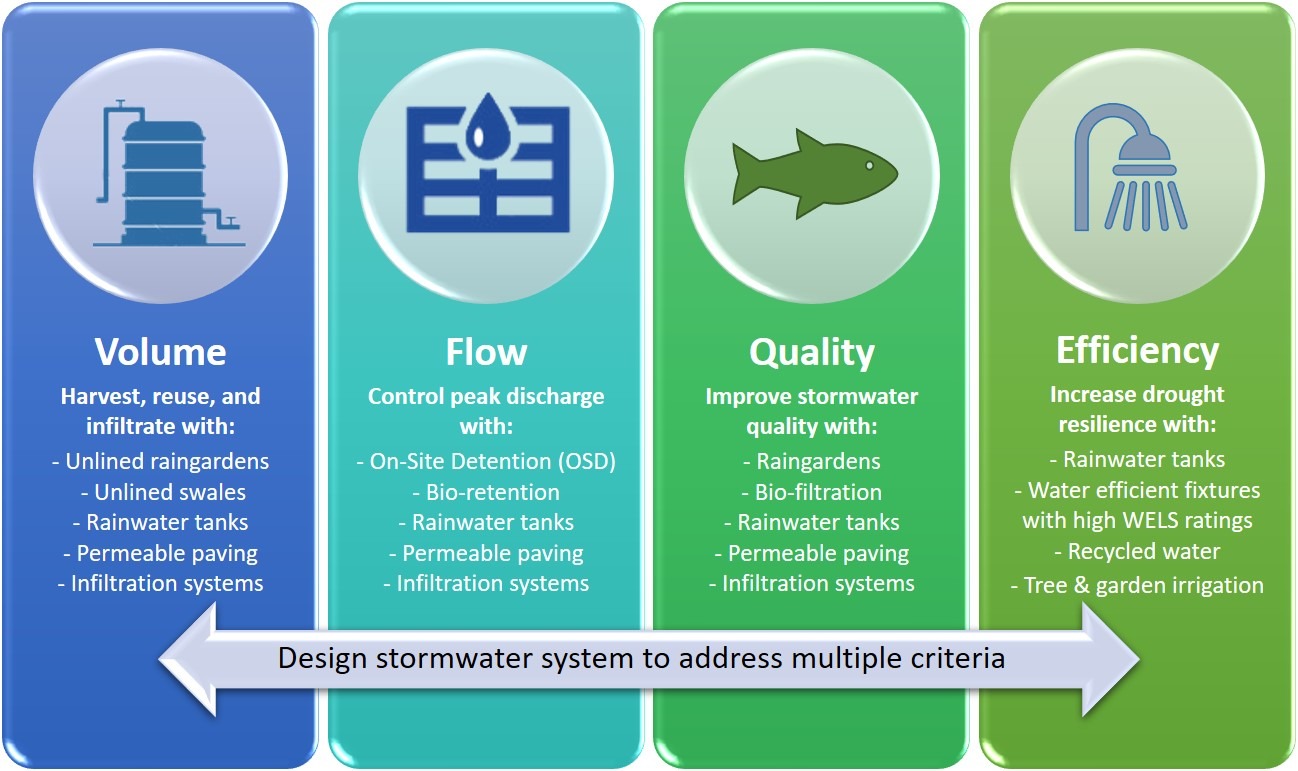
Figure 3: Integrated stormwater systems designed to address multiple criteria
Performance Objective 1: Volume – harvest and use or infiltrate stormwater
Development sited and designed to ensure the average annual runoff volume post-development is no more than 10% greater than pre-development volume
Performance objective 2: Flow – control peak stormwater discharge flows or volume
- Stormwater flow management performance measure – residential
– Post development peak rate of runoff from the development site for the critical design storm shall not exceed that from the pre-development site from a 5-year ARI (20% EY) storm event. - Stormwater flow management performance measure – commercial, industrial and institutional development
- Post development peak rate of runoff from the development site for the critical design storm shall not exceed that from the pre-development site from a 20-year ARI (5% AEP) storm event.
Performance objective 3: Quality – improve stormwater runoff water quality
Development sited and designed to improve the quality of stormwater and minimise pollutant transfer to receiving waters by incorporating measures that reduce annual pollutant loads by:
- 80% for total suspended solids
- 60% for total phosphorous
- 45% for total nitrogen
- 90% for gross pollutants
compared with untreated stormwater runoff,
Objective 4: Water conservation and water-use efficiency
Development designed to achieve 25% potable (mains) water reduction compared to a building that has no water saving features.
How do I demonstrate compliance with the objectives?
Table 3 Pathways to demonstrate compliance with the objectives

What typical stormwater management solutions can meet these objectives?
Many stormwater management solutions can meet multiple objectives as indicated in Table 1 below. There are a range of alternative options available depending on the nature of your development and any site constraints.
Table 1: Typical stormwater management solutions that can meet the performance objectives
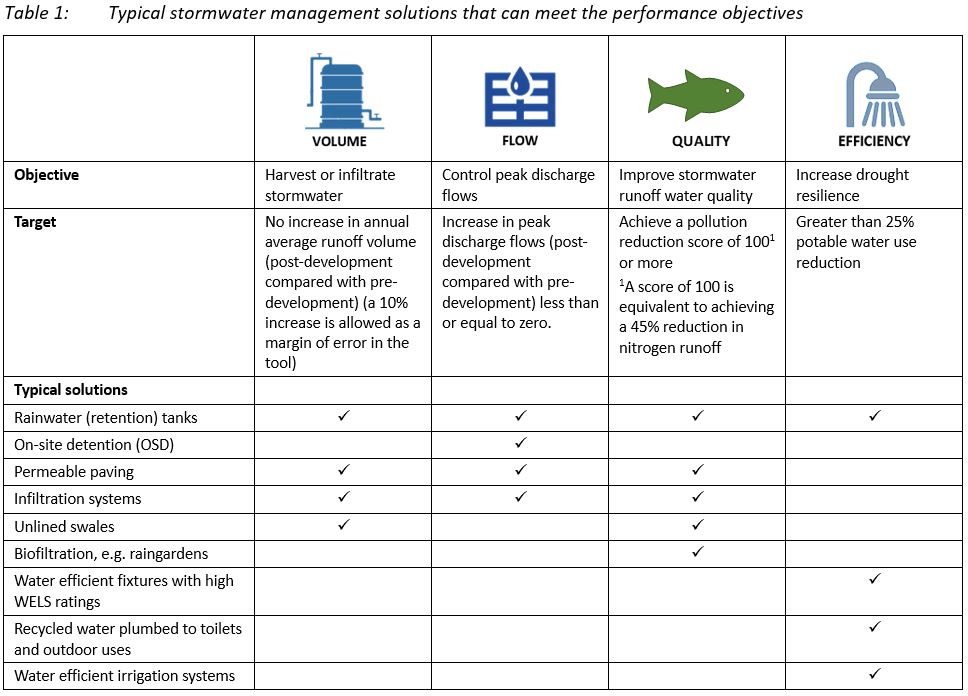
Deemed-to-satisfy solutions
What deemed-to-satisfy solutions exist for stormwater management at the allotment scale for residential development?Water Sensitive SA has developed a range of deemed-to-satisfy (DTS) solutions for stormwater management that integrate stormwater management objectives within the Planning and Design code, Building Code and a best fit of metropolitan Council engineering requirements.
Available DTS options include:
- rainwater retention tanks, to capture and use roof rainwater runoff
- combined retention and detention rainwater tanks, to capture and use roof rainwater runoff (retention or lower portion of tank) that also detain and slowly release a proportion of the storage volume in a storm event as a flood protection measure (detention or top portion of the tank)
- infiltration pits and trenches.
For more information refer to Water Sensitive SA’s:
- Guidelines for applicants WSUD 02: Residential development – small-scale, deemed-to-satisfy solutions
- WSUD 05: Concept drawings of standard WSUD treatments for small-scale development
- Standard drawings for:
-
- retention tank reticulation detail
- aboveground combination retention/ detention tank
- infiltration pit
- infiltration trench.
What is the difference between stormwater retention and stormwater detention in a combined retention/detention rainwater tank?
The retention portion of your rainwater tank maintains a storage of water for you to draw upon and use within your household. This storage is topped up with each rainfall event. The use of rainwater via retention tanks helps to meet objectives for water conservation and stormwater runoff water quality, and manage peak stormwater runoff flows and volumes.
The detention portion of your rainwater tank holds stormwater runoff for a short period of time following a storm (usually several hours) while it is slowly released via an orifice (small outlet in the tank) to Council’s stormwater drainage network. This slow release of stormwater runoff aims to manage peak stormwater flows in Council’s drainage network and minimise the risk of local flooding.
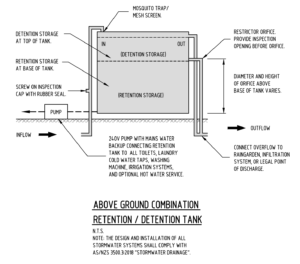
Combination retention detention tank detail
Why is there a shift in practice in favour of retention instead of detention solutions?
Urban stormwater design has traditionally focused on peak flow management only, however, design standards have evolved and now require stormwater design to consider the changes in catchment conditions that are created by urbanisation. Engineers Australia now recommends the design and installation of stormwater volume reduction and water quality improvement systems as part of stormwater drainage design (ARR 2016). Retention and use solutions, such as rainwater tanks plumbed for household uses or infiltration trenches or pits, reduce the volume of stormwater that reaches the drainage system and ultimately streams and marine environments, contributing to multiple objectives as indicated in Table 1.
Table 1: Summary of benefits of retention versus detention
1 Adapted from Australian Rainfall and Runoff Guide – ARR 2016, Engineers Australia 2016, see Chapter 9 (Urban Drainage)
How do the deemed-to-satisfy requirements differ from the building code requirements?
Table 2 below indicates the differences between the Building Code of Australia (SA Appendix) requirement and the DTS solution, if you choose a rainwater tank DTS solution.
Table 2: Rainwater requirements of Building Code of Australia (for water efficiency) compared with deemed-to-satisfy solutions (for water efficiency, and stormwater runoff quality and quantity management)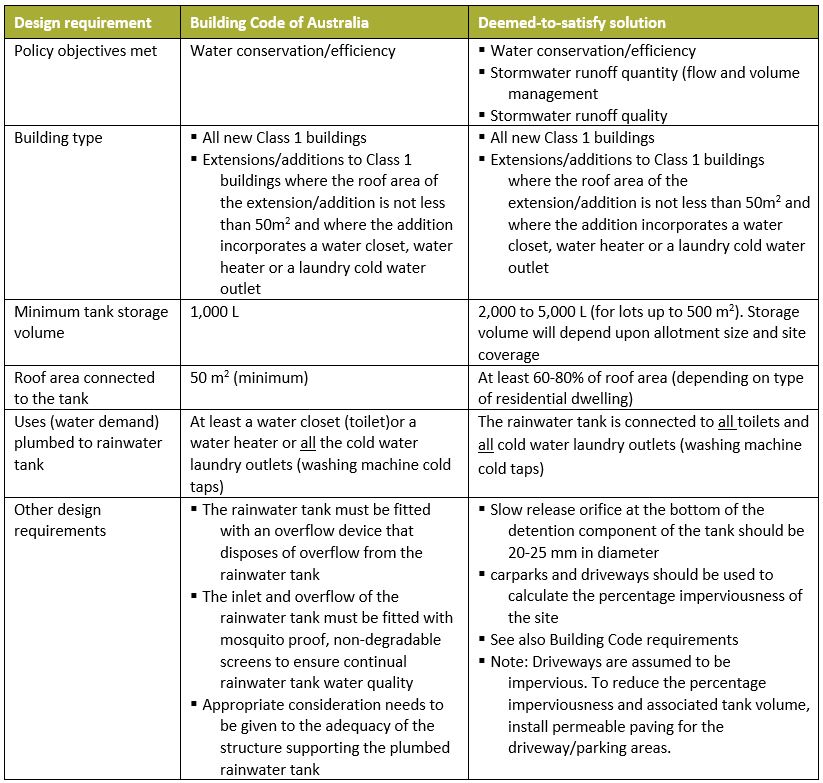
If I implement the deemed-to-satisfy solutions, are these the only stormwater runoff quality and quantity measures required?
Yes –these stormwater management measures generally achieve the objectives for the management of stormwater runoff quality and quantity for metropolitan Adelaide (exclusions may apply, check with your local Council). Concessions with respect to achievement of the stormwater objectives have been made for the retention only rainwater tank option in the interest of providing a simplified solution for compliance purposes.
The DTS solutions take into account:
- the area of the site and the proportion of site imperviousness (or site coverage)
- the mandatory plumbed rainwater tanks for Class 1 buildings requirements under the National Construction Code’s Building Code of Australia (Volume 2) – BCA 2016 Volume 2. Refer to Appendix A Additions, South Australia, SA 2 Water Efficiency.
Do I have to choose infiltration as my stormwater management solution?
No – infiltration is only one option to consider.
However, if the site has suitable soils and site conditions, infiltration is one of the best stormwater management solutions you can choose as it reintegrates water back into the urban environment to sustain vegetation that helps to keep our communities cool.
Guidance on sizing of infiltration systems, including suitable offset distances from structures, i.e. building footings, is provided in the Minister’s Specification SA 78AA September 2003 – On-Site Retention of Stormwater.
If you propose to use infiltration systems in a situation that falls outside this guideline, advice from a qualified structural engineer should be sought.
Stormwater management solutions for small-scale developments that fall outside the deemed-to-satisfy tables
For commercial development less than 5,000 m2, larger residential development sites (gross area of the allotment to be subdivided is above 800 m2 and less than 2,500 m2) and for sites where the deemed-to-satisfy solutions are unsuitable, compliance with the stormwater management performance objectives can be demonstrated by applying the InSite Water tool instead.
InSite Water is an integrated water management and stormwater assessment tool for use on small-scale development sites in South Australia requiring quick and accurate design answers. This tool will allow you to optimise design solutions to manage stormwater runoff, assessed against the South Australian water sensitive urban design policy and agreed Council performance criteria.
The InSite Water tool can also be used to demonstrate compliance with stormwater management objectives for commercial development with a gross area of the allotment to be subdivided of less than 5,000 m2.
Stormwater management solutions that can be assessed using the InSite Water tool are:
- rainwater retention tanks
- rainwater detention tanks
- combined rainwater retention and detention tanks
- water efficient fixtures and appliances
- permeable or porous paving
- infiltrations pits and trenches
- raingardens
- grassed buffers and swales
- green roofs.
Rainwater quality
How do I ensure that the rainwater in my tank does not become discoloured?Leaves from trees adjacent to your house and other airborne debris can make their way into your rainwater tank and cause the water to become discoloured. There are several ways to improve the quality of the rainwater you harvest from your roof, including installation of:
- GUTTER MESH (6 mm wire mesh) to prevent leaves and debris from blocking gutters.
- RAIN HEADS to downpipes to stop gutters blocking. Rain heads deflect leaves and debris and keep mosquitoes out of pipes that hold water. See Figure 2.
- WATER DIVERTER to prevent the first flush of most contaminated rainwater from entering the tank. Also known as “first flush diverters”. See Figure 2.
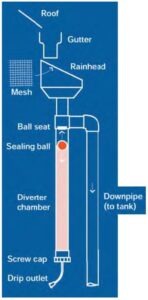
Figure 2 Rainhead and first flush diversion device. Source: City of Unley
Guidelines & resources
For more guidelines and resources on how to meet these stormwater management objectives refer to






